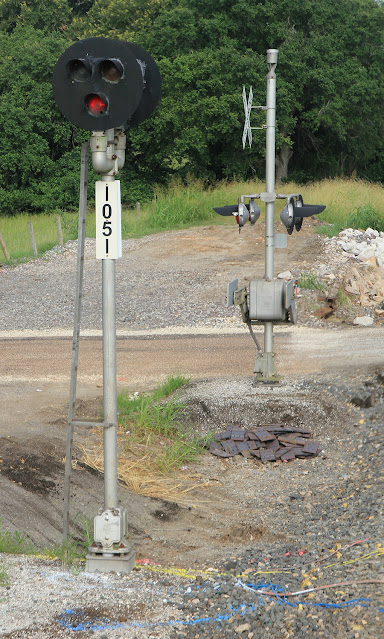I have previously discussed how railroads used milepost number places as an easy way to distinguish absolute from intermediate (ie permissive) signals. Like pretty much every other facet of signaling I've covered these vary railroad to railroad and past to present so I figured I'd compile a guide to railroad number plates (which are distinct from Station Signs).
Beginning with CSX, they use a white on black sign of medium side using a distinctive font that has been pretty consistent since the Chessie era. The number is the milepost in tenths, ie without a decimal point. If there is more than one main track is will be represented by a dash and the track number. Bi-directional signals use an odd-even system with one direction being the nearest odd 10th and the other being the nearest even 10th. The choice of odd-even is not necessarily consistent across an entire line.
CSX also has a compact style that has appeared at various points around the system such as the Trenton Line and former RF&P.
Speaking of Conrail, they used what is perhaps the best number plate system with a whole milepost followed by the track number followed by a directional letter. If there was only a single track the track number 1 would always be used.
 |
| Trenton Line MP 30 Track 1 North |
 |
| PRR Main Line MP 124 tk1 West. Note Conrail letters re-skinned by NS. |
NS honors the former Conrail system on former Conrail territory, but replaces the unit number plates with a modular type, similar to what the original PRR used.
On NS's other territories a milepost in 10ths with no decimal is used with the odd-even system in effect.
Until around 2000, former Southern territory used a large black on white sign and before that bare reflectorized numbers mounted to the mast. Signals not only use the odd-even system, but where there are more than one track, the tracks will use sequential odd or even 10ths creating a spread of 4/10ths per signal location.
The Southern preferred a vertical orientation, but by 2000 NS was using horizontal white on black signs before switching over to the current white on black modular numbering.
Similar to its interlocking signs, Union Pacific has implemented a uniform system of compact vertically oriented black on white signs with decimal point-less 10th of a mile precision using the odd-even system.
Where there is more than one track the track number is provided, separated from the milepost by a bar. This means that on some western main lines, number plates can display up to 6 digits.
Some former Southern Pacific number plates remain using a white on black horizontal format along with the Southern style staggered odd-even system on multi-track lines.
DRG&W practice seems to have been just painting the number in black on the light metalic mast.
BNSF is perhaps the most consistent using a white on black horizontal format down to the 10th with no decimal. BN multi-track practice does not differentiate between tracks, while the ATSF system uses sequential odd-even. Original ATSF signs also use a black on white format.
CN(IC) uses a black on white plate with the track number and a dash before the milepost in 10ths.
While CP (SOO) uses a vertical format white on black with the first digit being the track number followed by the milepost in 10ths.
However on the old D&H, CP uses a milepost number complete with decimal point. Unfortunately I did not have an example of double track.
The Guilford Rail System previously used a vertical white on black style with the 10th part of the milepost separated by a bar.
However newer examples are white on black with mileposts in 10ths and the track number appended after a dash.

Track is not usually specified, although the Springfield Line did specify track after a dash until the line went Rule 562.
On former PRR electrified territory, the need to fit the catenary signal mount bracket and vary in age, style and modularity.
NJT uses white on black even-odd mileposts in 10ths with a - track number suffix, but also likes using line prefixes like A for Atlantic City, L for the NJCL and M for the M&E.
Where SEPTA still has automatic signals, they append the track number directly to the end of the milepost in 10ths.
 |
| Reading Main Line Milepost 2.9, tracks 1 and 2. |
Last but not least, the Reading and Northern uses a very unique company branded green and yellow number plate with a Conrail style whole milepost number and directional letter.
I'm sure that I've missed more than a few other companies, but these are the ones that I have readily available photos for. Also METRA territory is such a mash-up of ownership that I could probably do an entire post on it alone!


























Looking to sell your number plate? We provide a seamless service to help you find the right buyer for your personalized registration plate. Our expert team will guide you through the entire selling process, from evaluating the market value of your plate to advertising it effectively across various platforms. With our extensive network and marketing strategies, we aim to maximize your selling price while minimizing the time it takes to find a buyer. Whether it’s a cherished number plate or a unique registration, we ensure a hassle-free experience, allowing you to achieve a successful sale with ease. Contact us today to get started! Unlock the full potential of sell my number plate by clicking here to access our exclusive content, including how-to guides, FAQs, and customer testimonials.
ReplyDelete